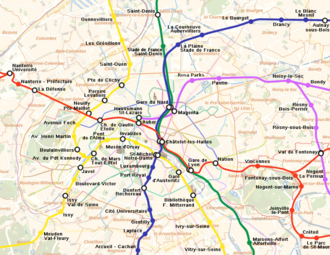Réseau express régional d'Île-de-France
The Réseau express régional d'Île-de-France is a rapid transit network ( S-Bahn ) in the greater Paris area and Île-de-France . On a route network of 587 km with 258 stations, five lines are used by two different operators. Lines A and B are served jointly by RATP and SNCF , lines C, D and E by SNCF alone. Around 2.7 million passengers use the RER every day. RER is the abbreviation for Réseau Express Régional , meaning regional express network. The special importance of the RER network lies in the fact that, in contrast to the suburban trains of the Transilien, it crosses the capital Paris in tunnels and thus creates continuous connections from the suburbs via the center to the suburbs in the opposite direction. Within Paris, the RER is a kind of express connection to relieve the Paris Metro . The RER network includes the RER A line with 1.4 million passengers a day, the most-used railway line in Europe, which is also one of the most-used railway lines in the world, and the RER B line, with 950,000 passengers daily, the second most used railway line in Europe.
history

In contrast to other metropolises such as New York , Berlin , Vienna or Hamburg , which already had connecting railways as urban elevated railways before the Métro , such projects in 19th century Paris did not get beyond the discussion and instead the decision was made to use a purely urban Métro - Build a network. This meant that S-Bahn-like transports were initially off the table until the 1970s.
The current RER has its origins in the suburban railways that were shut down by the SNCF or its predecessors. The operation of the southern section of today's RER B was taken over by the then Paris Métrogesellschaft as early as 1937. In 1969, the RATP took over another line (what is now the eastern section of the RER A), the terminus of which was moved from the Gare de la Bastille to the Nation underground station . Shortly thereafter, a new railway line was put into operation in the west to connect the suburb of La Défense , where the Parisian high-rise district was just emerging.
The real “birth” of the RER is in 1977, when the two parts of line A were linked by a tunnel and line B was also run in a tunnel to the shared station Châtelet-Les Halles . This station is located on the site of the former Parisian market halls. At this point at the latest, the SNCF recognized the success of the concept and since then has taken over the opening and operation of the following lines:
- The RER B was extended north to the Gare du Nord and connected to regional lines ending there. For this purpose, underground platforms were built at the Gare du Nord.
- In 1979, the SNCF connected the terminus Invalides and Orsay through a short stretch of tunnel along the southern bank of the Seine , thus forming line C. The last two head stations of regional traffic were abolished. In 1988, the Saint-Michel Notre Dame station was built at the intersection of lines B and C on the southern bank of the Seine.
- Since 1987 line D has been running from Châtelet-Les Halles through the B tunnel to Gare du Nord and from there via regional lines not yet served by the B into the surrounding area . In 1995 it was routed in a new tunnel parallel to Line A via Gare de Lyon and from there also runs over the tracks of existing regional lines to the surrounding area.
- In 1999, line E went into operation with the new stations Haussmann - Saint-Lazare (near the Saint-Lazare train station ) and Magenta (between Gare du Nord and Gare de l'Est ). There the line runs to the east over existing regional tracks. In the future, the line is to be continued westwards from Saint-Lazare. It is currently unclear which current suburban lines of the Saint-Lazare station will take over line E in the west in the future. At the La Défense train station , however, advance payments for an RER line should already be made. Due to empty coffers, the construction of line E in the west has not yet been started.
Outside Paris, the RER and the SNCF usually share the tracks with the rest of the regional, long-distance and freight traffic in the Île-de-France . The RATP operates large parts of line A (with the exception of the branches to Poissy and Cergy-le-Haut) and the southern part of line B. On both lines, the tracks are exclusively reserved for RER trains, even if parts of the lines were originally from operated by the SNCF or its predecessors.
A special feature of the RER is that the destination displays of the trains contain four-digit codes (“codes missions”) that contain information about the starting station, the destination station, stops and the branches used by the respective train.
The line network
The network consists of 5 lines with a total of 587 km of tracks and 258 stations. (As of January 2016)
There are around 2.7 million passengers a day.
Most frequented train stations
| station | Passenger volume in millions (2013) | place |
|---|---|---|
| Gare du Nord | 46.8 | Paris |
| Gare de Lyon | 35.3 | Paris |
| La Defense | 30.2 | Puteaux |
| Nanterre-Prefecture | 23.1 | Nanterre |
| Châtelet-Les Halles | 18.4 | Paris |
| Val de Fontenay | 11.9 | Fontenay-sous-Bois |
All other stations have fewer than 10 million passengers. Only the number of boarding passengers for 2013 is given. Transferring persons were not recorded.
RER and Métro
The relationship between the RER A and the Métro is also interesting . The route of the A tunnel was originally chosen to relieve Métro 1 between the Charles de Gaulle - Étoile and Nation stations . But because the new RER line went much faster and further than the Métro, it soon attracted so many passengers that it was itself overloaded. Therefore, the D-South line could not be run through the A tunnel, although D-North shares a tunnel with the B. To relieve the RER A, Métro 1 has now been extended parallel to the RER from Pont de Neuilly to La Défense , but this again attracted new passengers due to the additional stations on this section. The last move in the matter was the opening of Schnell-Métro-Line 14 , which runs on a section parallel to the busiest part of the RER A (and Métro 1). Line 14 has only a few stops on this section , so that it goes there at high speed on the S-Bahn . After the opening, line 14 relieved the load on the RER A. With the further increase in passenger numbers in the central section of line A, the brief shift in passengers was quickly compensated for. In addition to the inner city route, the race will continue in the west of the city: an extension of Métro 1 to Nanterre , still parallel to RER A, is being considered.
Single tickets ticket t + and monthly tickets for the Paris metropolitan area are generally valid for the entire Métro network. The branches in the suburbs outside the actual Paris city limits are also included, regardless of the tariff zone in which they are located. In contrast, a distance tariff applies to the RER, i. H. For trips beyond the city limits to or from a station in the banlieue , ticket t + are invalid and monthly tickets must be valid for the corresponding zones.
Use of the RER in Paris
As an express line network, the RER is only suitable for transport within Paris to a limited extent, as the RER only offers a few, far apart stops at a considerable depth (below metro level) with correspondingly long access routes. The Métro network is much denser and has shorter distances between stops. The RER is therefore mainly used by inbound and outbound commuters from / to the outskirts and less for transport within the city itself.
This applies in particular to lines D and E, which have very few stations within Paris, while line B creates a fast north-south connection with an average stop distance and serves stations that are not served by the metro. Line C creates cross connections on the southern bank of the Seine and on the western outskirts that complement the metro network.
Where Métro and RER provide a connection to the suburbs (for example to La Défense ), traveling with the RER is usually faster and therefore more practical. However, all metro stations can be reached with a ticket t + or a season ticket for zones 1 and 2, even if they are actually in zone 3. Therefore, taking the metro on these routes can be cheaper than taking the RER.
Due to its lesser importance within Paris and the somewhat more complicated timetable structure, the RER is rarely used by visitors from outside the city, apart from the lines to the Palace of Versailles , Disneyland Resort Paris or one of the Paris airports, all of which only take the RER or bus, but not can be reached by metro.
Airport connections
The Paris-Charles de Gaulle Airport is directly accessible by the RER line B, which stops at Terminals 1 and 2. FIG. At both stations you can change to the CDGVAL airport shuttle , and at the station at Terminal 2 ( Aéroport Charles-de-Gaulle 2 TGV ) you can also change to the TGVs.
The Paris-Orly airport is opened to one of the RER C, from the stop Pont de Rungis - Aéroport d'Orly even a shuttle bus to the airport runs.
On the other hand, the RER line B also offers a connection at the Antony stop , from which the Orlyval runs to the airport.
Punctuality of the RER lines
Users of the RER trains sometimes criticize the fact that the system suffers from deficiencies and that the trains are often unpunctual or even fail completely.
And rightly so, as the table below shows. The target and actual values are based on an agreement between the person who ordered the trips (STIF) and the operators (RATP and SNCF) performing the trips: The actual value corresponds to the percentage of travelers who arrive at their destination station on time or with reach a maximum of 5 minutes delay. If the specified target value is exceeded, the operator receives a bonus on the agreed payments from the STIF; if the target value is not met, the operator is obliged to pay penalties.
| line |
|
|
|
|
|
| Setpoint in% | 94 | 94 | 93 | 92.5 | 95 |
| Actual value 2012 in% | 86 | 84 | 91 | 84 | 95 |
| Actual value 2013 in% | 84 | 83 | 90 | 83 | 95 |
The table shows that only line E reached the target value and that punctuality fell further in 2013 compared to the previous year.
Vehicles and their maintenance
Current vehicles
| vehicle | photo | Lines |
|---|---|---|
| Z 20900 | 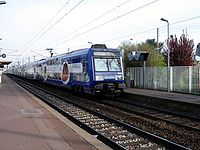 |
|
| Z 5300 |  |
|
| Z 5600 | 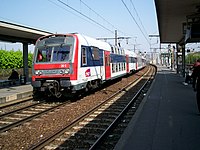 |
|
| Z 8800 | 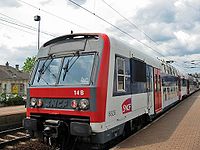 |
|
| Z 20500 | 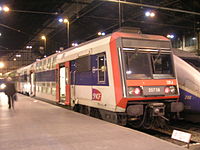 |
|
| Z 22500 |  |
|
| MI 2N Altéo |  |
|
| WED 09 |  |
|
| Z 8100 / Z 8400 | 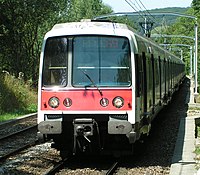 |
|
| MS 61 |  |
|
Depot for RER trains
Lines A and B
The trains on RER lines A and B are serviced in the RATP depots.
Depots in Sucy-en-Brie , Nanterre (Rueil-Malmaison depot) and Torcy are responsible for trains on Line A.
The workshops in Massy (Massy-Palaiseau depot) and in Mitry-Mory (Mitry-Claye depot) are used for trains on Line B. The Mitry-Claye plant is a special case: it is a branch of the SNCF's Technicentre Paris-Nord depot, but only RATP employees are employed there. Only the SNCF Z 8100 series is serviced.
Lines C, D and E
These lines are operated by SNCF, so the trains are also serviced in the SNCF depots. Trains of the Transilien network are also looked after in these workshops .
- Line C: Maintenance is carried out in Vitry-sur-Seine (Les Ardoines depot) and in Trappes .
- Line D: Maintenance is carried out in Villetaneuse (Les Joncherolles depot) and in Villeneuve-Saint-Georges
- Line E: For this line there is currently only one depot in Noisy-le-Sec .
See also
literature
- M. Gaillard: You Madeleine-Bastille à Météor: histoire des transports parisiens . Amiens, Martelle 1991, ISBN 2-87890-013-8 .
- Bernard Collardey: Les trains de banlieue . tomes I et II, 1999, ISBN 2-902808-76-3 .
- François Maspero : Les Passagers du Roissy-Express . Ed. du Seuil, 1992, 328 p. ISBN 2-02-014605-3 .
Web links
- Transilien SNCF (with route map from Paris )
- RER track plan
Individual evidence
- ↑ LCI.fr: RER A - "10 seconds de retard, 15,000 voyageurs affectés!" ( Memento of the original from October 12, 2009 in the Internet Archive ) Info: The archive link was automatically inserted and not yet checked. Please check the original and archive link according to the instructions and then remove this notice.
- ↑ leparisien.fr: Transports: usagers et élus disent "non au Charles-de-Gaulle express" oui "au RER B"
- ↑ Traffic annuel entrant par station (2013). Mairie de Paris, April 11, 2014, accessed June 8, 2014 (XLS).
- ↑ Le qualité des services en chiffres STIF publication from February 2014 , (French) accessed on September 3, 2014

